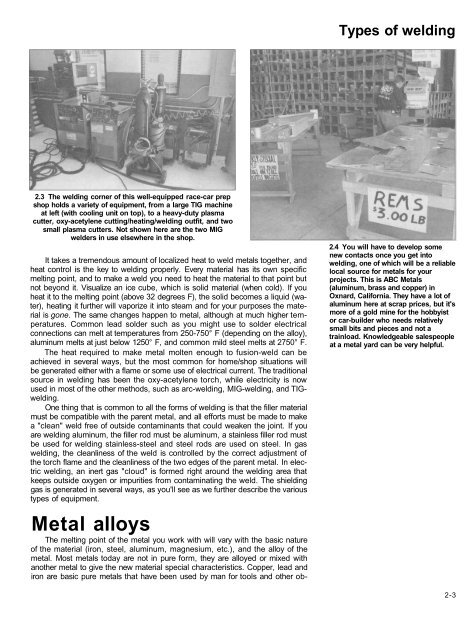The Haynes Welding Manual - VolksPage.Net
The Haynes Welding Manual - VolksPage.Net
The Haynes Welding Manual - VolksPage.Net
Create successful ePaper yourself
Turn your PDF publications into a flip-book with our unique Google optimized e-Paper software.
2.3 <strong>The</strong> welding corner of this well-equipped race-car prep<br />
shop holds a variety of equipment, from a large TIG machine<br />
at left (with cooling unit on top), to a heavy-duty plasma<br />
cutter, oxy-acetylene cutting/heating/welding outfit, and two<br />
small plasma cutters. Not shown here are the two MIG<br />
welders in use elsewhere in the shop.<br />
It takes a tremendous amount of localized heat to weld metals together, and<br />
heat control is the key to welding properly. Every material has its own specific<br />
melting point, and to make a weld you need to heat the material to that point but<br />
not beyond it. Visualize an ice cube, which is solid material (when cold). If you<br />
heat it to the melting point (above 32 degrees F), the solid becomes a liquid (water),<br />
heating it further will vaporize it into steam and for your purposes the material<br />
is gone. <strong>The</strong> same changes happen to metal, although at much higher temperatures.<br />
Common lead solder such as you might use to solder electrical<br />
connections can melt at temperatures from 250-750° F (depending on the alloy),<br />
aluminum melts at just below 1250° F, and common mild steel melts at 2750° F.<br />
<strong>The</strong> heat required to make metal molten enough to fusion-weld can be<br />
achieved in several ways, but the most common for home/shop situations will<br />
be generated either with a flame or some use of electrical current. <strong>The</strong> traditional<br />
source in welding has been the oxy-acetylene torch, while electricity is now<br />
used in most of the other methods, such as arc-welding, MIG-welding, and TIGwelding.<br />
One thing that is common to all the forms of welding is that the filler material<br />
must be compatible with the parent metal, and all efforts must be made to make<br />
a "clean" weld free of outside contaminants that could weaken the joint. If you<br />
are welding aluminum, the filler rod must be aluminum, a stainless filler rod must<br />
be used for welding stainless-steel and steel rods are used on steel. In gas<br />
welding, the cleanliness of the weld is controlled by the correct adjustment of<br />
the torch flame and the cleanliness of the two edges of the parent metal. In electric<br />
welding, an inert gas "cloud" is formed right around the welding area that<br />
keeps outside oxygen or impurities from contaminating the weld. <strong>The</strong> shielding<br />
gas is generated in several ways, as you'll see as we further describe the various<br />
types of equipment.<br />
Metal alloys<br />
<strong>The</strong> melting point of the metal you work with will vary with the basic nature<br />
of the material (iron, steel, aluminum, magnesium, etc.), and the alloy of the<br />
metal. Most metals today are not in pure form, they are alloyed or mixed with<br />
another metal to give the new material special characteristics. Copper, lead and<br />
iron are basic pure metals that have been used by man for tools and other ob-<br />
Types of welding<br />
2.4 You will have to develop some<br />
new contacts once you get into<br />
welding, one of which will be a reliable<br />
local source for metals for your<br />
projects. This is ABC Metals<br />
(aluminum, brass and copper) in<br />
Oxnard, California. <strong>The</strong>y have a lot of<br />
aluminum here at scrap prices, but it's<br />
more of a gold mine for the hobbyist<br />
or car-builder who needs relatively<br />
small bits and pieces and not a<br />
trainload. Knowledgeable salespeople<br />
at a metal yard can be very helpful.<br />
2-3

















